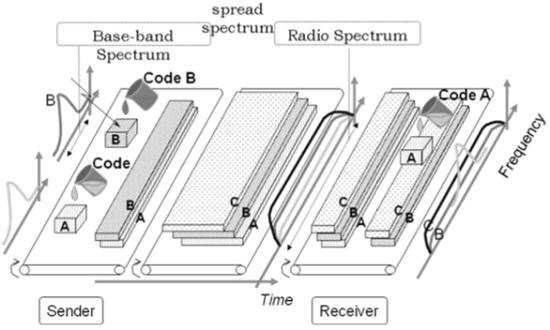What Is Code Division Multiple Access (CDMA) Technology?
Code Division Multiple Access (CDMA) is a wireless communication technology that allows multiple users to share a single radio channel while maintaining high security. CDMA “spreads” a radio signal over a wide frequency range, using a unique code to identify each transmitter/receiver pair. Many users can communicate on the same channel without natural interference, eavesdropping, or jamming.

ad
A Quick Look at Code Division Multiple Access – CDMA Technology
The Time-Division Multiple Access (TDMA) system is not at all like the frequency- and time-division multiplexing systems. A user has access to the full bandwidth throughout the entirety of the session when using this system. The fundamental idea behind the CDMA system is that different CDMA codes are utilized to differentiate between the various users.
There are two types of Spread Spectrum communications – Frequency hopping and Direct sequence.
Frequency hopping – In this method, the frequency is rapidly switched from one to another, and the receiver and transmitter are in synch always with an accurate clocking system.
ad
Direct sequence – Data signal is multiplied by Pseudo-random noise code. The digital data coding happens at high range frequency and code generation happens pseudo-randomly. The receiver is aware of the generation of the same code and the correlation of the received signal with the code used to extract the data.
Well, direct sequence spread spectrum modulation, also known as DS-CDMA, frequency hopping, and mixed CDMA detection are the techniques that are typically used (JDCDMA). In this instance, a signal is produced that is spread out across a broad bandwidth. To carry out this action, a piece of software known as spreading code is utilized. It is possible to select a signal with a given code in the presence of many other signals with different orthogonal codes by using a group of codes that are orthogonal to each other. This is accomplished by using a group of codes.
CDMA History
During the Second World War, the CDMA technology was first developed. It was developed by English allies as a means of safeguarding their wireless transmissions against interference from adversaries. After the war, Qualcomm was the company that received the patent for this technology and made it available for use in commercial settings. In 1995, Hutchison Telephone Company became the first company in the world to commercially launch a Code Division Multiple Access-CDMA system in Hong Kong.
How does Code Division Multiple Access-CDMA work?

With two PN codes in each voice packet, CDMA can handle up to 61 users on a 1.2288 MHz channel. In order to distinguish between calls and theoretical limits, there are 64 Walsh codes. Due to operational constraints and quality issues, the maximum number of calls will be lower than this.
In fact, multiple “signals” baseband with different spreading codes can be modulated on the same carrier to support multiple users. Using orthogonal codes, there is minimal interference between the signals. If multiple mobile stations send signals, the base station can isolate each one because the spreading codes are orthogonal.
The complexity of the Code Division Multiple Access-CDMA network is illustrated in the diagram below. We mixed the signals of all users during propagation, but you use the same code as the receiving side used at the time of sending the transmission. Each user’s signal can be extracted.
CDMA Top Features
CDMA’s key features include the following:
- Accurate positioning in the Global Positioning System (GPS)
- The entire spectrum is utilized by each channel.
- Greater ability to communicate via voice and data
- Synchronization isn’t necessary for CDMA
- The use of a unique code word for each user reduces the likelihood of a conflict.
- Used by some mobile service providers (Qualcomm standard IS-2000 known as CDMA2000)
- Less radiation is emitted
- Improved data transfer speeds.
- Fast Push to Talk and Email are supported by Code Division Multiple Access-CDMA.
- Utms 3G uses W-CDMA OmniTRACS uses CDMA for its satellite transportation.
Capacity of CDMA
Factors influencing CDMA capacity include
- Processing Gain
- Signal to Noise Ratio
- Voice Activity Factor
- Frequency Reuse Efficiency
When using CDMA, the capacity is soft because each frequency in the system is shared by all users, who are then separated based on their code. As a result, CDMA can function even in the presence of background noise and other forms of interference.
As a result, there is no way to reuse frequencies because they are shared by neighboring cells. If that’s the case, CDMA capacity calculations should be extremely straightforward. A cell with no code channel is multiplied by another cell. However, it’s not as simple as that. Even though there aren’t any 64-bit code channels available, the CDMA frequency is the same, so it’s possible to use it only once.
Centralized Methods
- The band used in CDMA is 824 MHz to 894 MHz (50 MHz + 20 MHz separation).
- The frequency channel is divided into code channels.
- 1.25 MHz of FDMA channel is divided into 64 code channels.
Processing Gain
An example of CDMA is the use of a spread spectrum. A code sequence disperses each bit of data. As a result, the amount of energy expended per bit rises. To put it another way, we benefit from this.
P (gain) = 10log (W/R)
W is Spread Rate
R is Data Rate
For CDMA P (gain) = 10 log (1228800/9600) = 21dB
It’s a measure of how fast data is moving. Typically, a signal-to-noise ratio of 7 dB is required for acceptable voice quality during typical transmission conditions.
Translated into a ratio, the signal must be five times stronger than the noise.
Actual processing gain = P (gain) – SNR
= 21 – 7 = 14dB
CDMA uses a variable rate coder
The Voice Activity Factor of 0.4 is considered = -4dB.
Hence, CDMA has 100 percent frequency reuse. The use of same frequency in surrounding cells causes some additional interference.
In CDMA frequency, reuse efficiency is 0.67 (70 percent eff.) = -1.73dB
Advantages of CDMA Technology
CDMA has a low hard capacity. The more codes there are, the more users there will be. As a result, it provides the following benefits
- CDMA suffers from a near-far effect, which necessitates strict power control. If a nearby user is transmitting at the same power as the base station, the signal will be drowned out by that user. At the receiver, the power levels of all signals must be roughly equal.
- It is possible to enhance signal reception with the use of rake receivers. Bit-level decisions can be made based on delayed versions of the signal’s time (a chip or later).
- Flexible transfer can be employed.. Switching mobile base stations does not necessitate a change in service provider. The mobile receives signals from two base stations and two base stations receive signals from the mobile.
- To minimize noise, you can use a transmission burst (TB).
There are some drawbacks to CDMA
Although CDMA has a lot of capacity, more users sharing a channel means more noise is generated. Individual receivers may experience a noticeable increase in power consumption as a result of this. The transmission tower’s range will be reduced as the noise level increases.
CDMA has many drawbacks, including the following:
- You have to be very picky about the length of the code. Large code lengths can lead to delays or interference, depending on the situation.
- Time synchronization is required.
- Temporary transfer increases radio resource consumption and may lead to reduced capacity on the receiving end.
- To maintain tight power control over the total power received and transmitted from a base station. As a result, there may be many handovers.
Is My Phone CDMA or GSM? How Could I Know?
Checking to see if your phone is GSM or CDMA (or both) can be done in five different ways.
Is There a SIM Card Slot on Your Phone?
If a phone had a SIM card slot or not, it was easy to tell what kind of band was supported. CDMA phones did not have a slot for a SIM card, whereas GSM phones did. This means that CDMA phones don’t require a SIM card because the phone number is linked directly to the device itself.
Due to the proliferation of 4G and 5G smartphones with built-in SIM cards, this approach is no longer viable. But if you don’t have a SIM card slot, your device will use CDMA technology instead. Although this is changing with the advent of the eSIM, it is still not a reliable option to check for a SIM slot.
2. Using the Settings App
You can also check the Settings app on an Android or iOS device to see if this is the case.
- Open the Settings app on your iOS device, select General, and then About.
- Open the Settings app on your Android device, select About phone, and then select Status.
As a result of Android’s fragmentation, the exact steps you take will vary from device to device. Check the MEID, ESN, or IMEI number in the About (iOS) or Status (Android) page.
CDMA phones have MEID or ESN numbers, while GSM phones have IMEI. if you see both networks, you have a phone that supports both GSM and CDMA
3. From Where Did You Buy Your Device?
CDMA and GSM compatibility is common in devices purchased directly from the manufacturer. Samsung and Apple’s direct-to-consumer phones are likely to support both.
A specific network band, on the other hand, is typically associated with carrier-locked devices. There are a variety of carriers that offer support for various frequencies. There are devices available from every wireless provider that are compatible with the frequencies used by that company’s network.
Both AT&T and T-Mobile use GSM technology, which means their smartphones are GSM-compatible. Although Verizon is a CDMA provider, the company’s smartphones are GSM and CDMA compatible. As a result, a Verizon unlocked smartphone can be used on T-Mobile or AT&T’s GSM networks without difficulty.
4. Check the Model Information on Your Phone
Look up the model number online to see if your iOS or Android device is a GSM or CDMA variant. The model number can be found on the back of your phone or on the packaging box it came in. Once you know your phone’s model number, you can check online to see if it supports GSM or CDMA.
5. Read the documentation provided by the product’s maker.
Details about your device’s network band are included in the paperwork that comes with it. If you know the model number of your device, you can look it up on the manufacturer’s website without the paperwork.
What’s There in Future, GSM vs. CDMA?
GSM and CDMA are only compatible with 2G and 3G networks, as stated above. The global LTE standard has been adopted by all 4G service providers. GSM and CDMA are only used as a backup in areas where LTE coverage is poor or non-existent. As we move into the 5G technology, the importance of the two network bands will diminish. Major US carriers will begin shutting down their 3G networks in early 2022, for instance.
ad



Comments are closed.